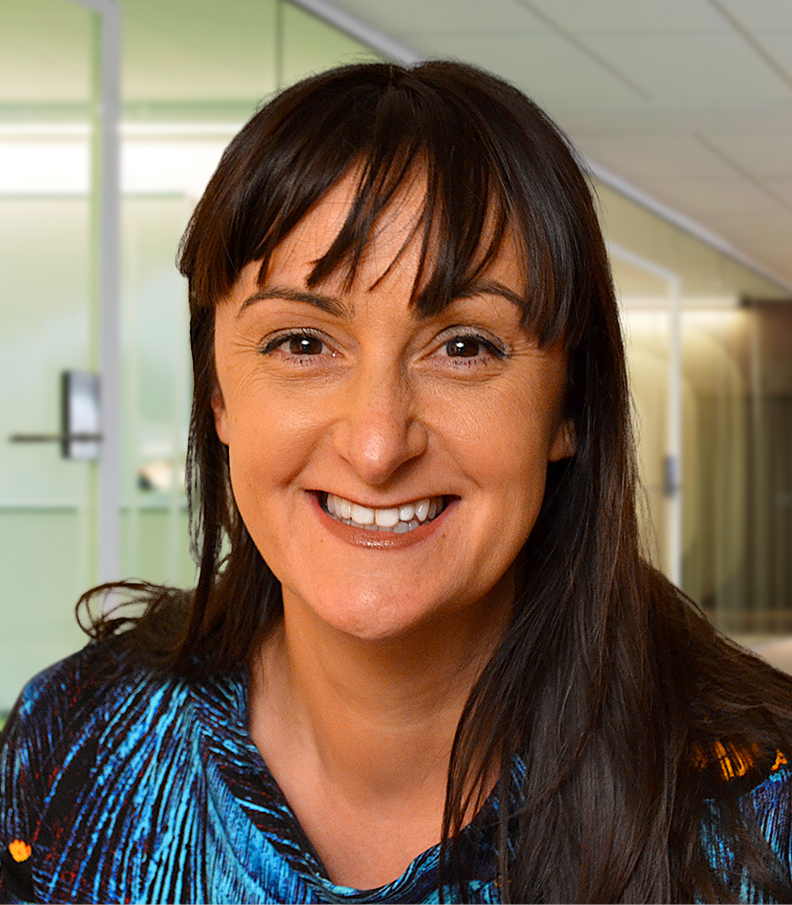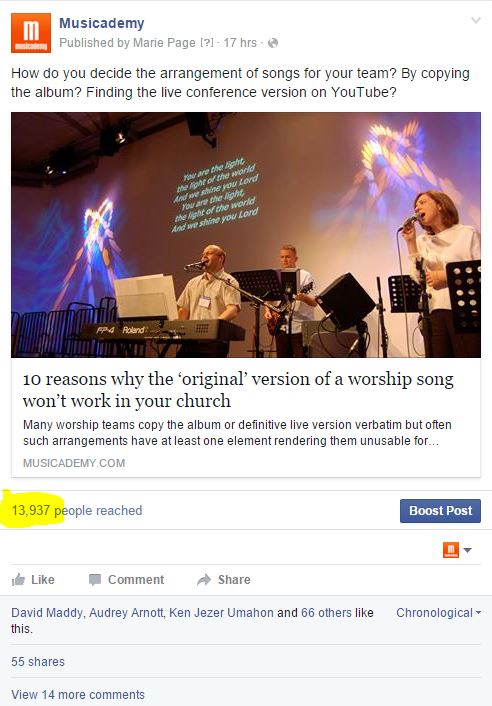I’ve been utterly despairing of Facebook’s organic reach recently. All the usual algorithm friendly tricks and techniques were failing miserably. Even the darling of Facebook, video clips that Facebook itself tells me is engaging (based on what it sees in terms of clicks as a percentage of views) have been dragging along at less than 5% reach. Clearly the drive to force us all into paying for visibility is well and truly kicking in.
The only content I’ve seen consistently good reach in recent months with are links to recognised news/media/publishing sites and the occasional quirky post like uploading a new photo album (and even then I was applying a host of tricks to improve the reach). So links to relevant content on The Telegraph, New York Times, BBC etc etc all do well but they don’t exactly help us to showcase our own material, they merely demonstrate that we are good content curators.
With a fan base of just over 13,000, I’d describe my Musicademy Facebook Page as a passion brand – our subscribers are highly engaged with our subject matter and feel strongly about the content (a mix of music and Christianity) we publish. Traditionally passion brands have enjoyed higher reach than the usual FMCG and similar thanks to higher engagement driving reach.
In recent months we’ve published links to newspaper articles from British, Canadian and American news/media sites and seen reach of 20-50%. These have included articles about the banned Church of England ad for The Lord’s Prayer, the new religious Post Office stamps, how music lessons trump reading for childhood development and some research about how apparently the children of religious parents are less generous than their peers. Much of the other content – plain status updates, photos, videos, links to our own site etc have tanked without the magic boost button.
I was really getting ready to call time on any reliance on Facebook as a “free” communications channel when something astonishing happened. 17 hours ago I published a link to an article on our website. We’re currently enjoying reach of over 100% (I’ll caveat that shortly) and my faith is somewhat restored. It feels like the good old days are back again.
100% reach? Really?
Well yes and no. Page Admins will be well aware that Facebook shows you the number of people a post reached (you can see that at the time I took the screen grab above this post had reached 13,937. Not bad for a Page of 13,291 fans. But on doing a bit of digging, I can soon discover that most of this is, in fact, viral reach.
You need to export your Insights data in order to identify the reach to your actual fans (see Export box below)
The post data is a large and detailed csv file which includes a column (T) called:
“Lifetime: The number of people who saw your Page post because they’ve liked your Page (Unique Users)”.
The key figure for the post in question is 4,227.
4227 (number of fans who had seen the content) divided by 13,291 (total number of fans) shows a reach to the fan base of just 32%. The rest of the reach is due to viral reach – people Liking or commenting on the post resulting in it either appearing on their own timelines, or in the FB “ticker”. 55 people shared the post which will have further boosted viral reach considerably. And inevitably some of those people that have seen the post as a result of viral reach will in turn have spread it to their friends.
My conclusion from all this, and from experiments I’ve run elsewhere, is that Facebook throttles reach to fans of even the most engaging pieces to a max of about 35%. You simply won’t get more fan eyeballs on your content without paying to boost it (and with a piece as sticky as this I’m happy to do so – it’ll drive a lot of traffic to the site and the viral cycle starts again).
I posted a link to an article on our blog yesterday and it’s had 90% reach (fan base size is 13,200). Crunching the numbers I see that this is actually 30% of fans and the rest the result of viral reach (no promotion at all).
What was the secret to getting over 100% reach?
So folks, I’ve got it sussed. Huge reach is back to stay so long as you follow my tried and tested methodology.
If only….
The success of this piece was, in reality, down to a number of intersecting factors. But I think it will help you (and me for future updates) to unpack those a little.
- Really decent article that hit all the right buttons for our fans.
It’s the content stupid.
You only get a viral effect with top notch content. Whether that’s a funny hamster eating a carrot while wrapped in a blanket video, or something nice and meaty like my piece was. And it still has to be packaged in a way that enables your audience to make the mental connect “This is relevant/interesting/amusing for me. This is worth clicking on.” - A decent headline
I’m not a great headline writer so I used one of those top 10 devices but tried to avoid the content disappointing. If you write a great headline but users instantly bounce from the article, Facebook knows it and will penalise the piece for being clickbait - Good copywriting in all three areas
With a link post you get three places to write copy – the headline, the text under the headline and the text above the image. I like to write something different in each, and if possible write in an engaging way at the top – in this instance I was positively inviting engagement by asking some somewhat accusatory questions (courting controversy is often good for engagement and reach) - A genuine (good sized) photo
Whilst I’ll often use (paid for) stock photos, I’m aware that these can look like, well, stock photos. (And anyway, the Facebook algorithm prefers something entirely fresh that’s not been indexed on OpenGraph before). An image that looks genuine, where the user can imagine themselves in that situation, is sometimes what is called for. I therefore chose a photo taken by a friend of mine at a local church. It illustrated the written content well and would be a very familiar image to our users.
And note how the photo was well proportioned, landscape in shape and crucially wider than 600 pixels meaning that you get full screen width rather than a thumbnail size. - Posted it at an optimal time for worldwide audience
60% of my fanbase is in the US so to capture both the UK and US audience I need to post as late in the day as possible – this was about 7.30pm - Lots of initial engagement
The early signals Facebook gets are crucial to it’s decision to show the content to a wider selection of your fans. This piece got instant clicks, comments and shares all of which drove reach. - Social proof
All those Likes, Comments and Shares indicate to new eyeballers that this is a decent piece of content and they are positively missing out by continuing to scroll without clickingThere are probably more reasons that you can identify, and we’ll be milking this content on other communication channels for weeks to come.
I’ve shared this not to brag but merely to encourage you that if the content is right, you can still achieve something good organically with Facebook
And I think I’m going to boost the post now so that those remaining 70% of fans get a chance at seeing it.

